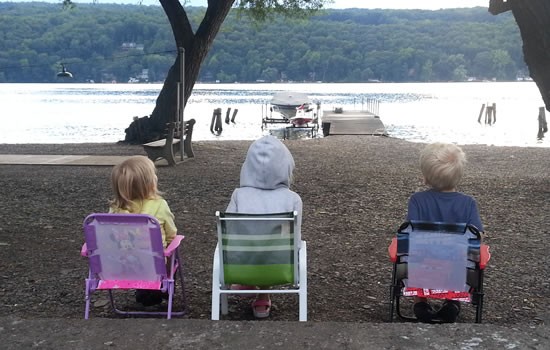― HOUSEHOLD CHEMICALS ―
Some of the products found in American homes have chemical ingredients that are potentially harmful. Look under the kitchen sink, in the bathroom, the garage, and the basement for examples. There you'll find oven cleaners, paint removers, bug killers, solvents, drain cleaners, and more. These products are potentially harmful to people and to the environment and should be used with care.
Public concern about the use and disposal of hazardous chemicals has grown dramatically in recent years. Several federal laws regulate the generation and disposal of hazardous materials in industry. There is, however, no regulation of household hazardous wastes which must be properly disposed of by the individual consumer.
The following is a description of the different types of products commonly used at home and the appropriate disposal methods for each.
Household Cleaners
Many of the products used at home, such as soaps and detergents, are meant to be washed down the drain. These products are biodegradable and, if the wastewater from your home is properly treated, they pose little threat to the environment.
There are however, products commonly found on kitchen shelves that are toxic to people and to the environment. Oven cleaners and spot removers are examples. Check the labels of products such as these for toxic components: lye, phenols, petroleum distillates, and trichlorobenzene. Products containing these chemicals pose a potential threat to health if improperly used and may also pose environmental hazards when discarded.
It is often possible to use an alternative, less toxic method to clean and polish. Ovens, for example, can be cleaned by applying table salt to spills, then scrubbing with a solution of washing soda and water. A combination of lemon oil and linseed oil makes a good furniture polish Clogged drains can sometimes be cleaned with a metal "snake" instead of toxic chemical cleaners.
When you feel that it is absolutely necessary to use a product containing toxic chemicals, the following cautions should be observed. As with pesticides, the rule of thumb is to read the label and to use the product only as directed. Some products become even more dangerous when mixed with others. For example, chlorine bleach mixed with ammonia can produce deadly chloramine gas. Protective clothing and rubber gloves may be necessary. Good ventilation is a must.
A Word About Detergents- One of the most used home cleaning products is detergent. Many of the detergent products formulated for automatic washing machines and dishwashers contain phosphorus, which has been shown to cause water quality problems in streams and lakes. The detergent industry has responded to this problem by developing products that contain little or no phosphate. For example, all liquid detergents are phosphorus-free, as are some powders. Again, the label will clearly tell you the phosphorus content. The range is from about 13 percent, in some automatic dishwasher detergents, to none. When you have a choice, buy the low phosphorus product. In New York State, the amounts of phosphorous allowed are .5% by weight for laundry detergents and 8.7% by weight for dishwasher detergents.
Car Care
Motor oil, battery acid, gasoline, car wax, engine cleaners, antifreeze, degreasers, radiator flushes, and rust preventatives are examples of automotive products containing toxic chemicals. Some car owners do their own maintenance work. Twenty-five percent change their car's oil and many of these people pour the used oil down the storm drain. One quart of oil can contaminate up to two million gallons of drinking water. The oil from one engine-four to six quarts-can produce an eight acre oil slick on the lake.
The only recommended way to dispose of used oil is to put it in a sturdy container, like a plastic milk jug, and take it to your neighborhood garage or oil recycling center. State law requires sellers of oil to have facilities to accept used oil.
Disposing of antifreeze is also a problem. Antifreeze contains ethylene glycol, which is poisonous to people, fish, and wildlife. Many cats and dogs have died after drinking sweet tasting puddles of antifreeze they find on driveways in the winter. Some antifreeze/coolants on the market such as Sierra Antifreeze are not as harmful to the environment.
Instead of pouring antifreeze down the drain or washing it into storm drains, ask your local service station to add the liquid to their used antifreeze storage drum.
Disposing of Household Toxics
The kinds of household toxics described in this section should not be disposed of "down the drain" or on the ground. Your drain leads either to a home septic system or a municipal treatment plant, neither of which is designed to completely remove toxic chemicals from wastewater. At least some of the toxics pass through the treatment process and end up in a stream, river, or groundwater. Substances poured on the ground or into a gutter can seep into groundwater or storm sewers which often dump into the nearby stream.
Effective sewage treatment is essential for treating the large volume of wastewater coming from our homes. Well-run treatment plants remove some nutrients, organic materials, and heavy metals from wastewater. Chlorine used to disinfect can be removed by a process called dechlorination. Individuals and communities should insist that the publicly owned treatment plants that serve them are maintained and operate at peak efficiency. This may mean added cost to consumers, but is essential for good water quality.
In many areas, local landfills or transfer stations are the only disposal site available. While probably better than flushing a toxic chemical down the drain, landfills are not a good long-term solution to our waste disposal problems. New energy needs to go into finding better solutions.
Where household hazardous wastes must be sent to a landfill, a couple of steps can be taken to reduce the environmental risk. First, wrap the product in its original container in newspaper and then wrap in an old plastic bag. Liquids can be poured into containers filled with absorbent kitty litter, then wrapped in plastic for disposal.

